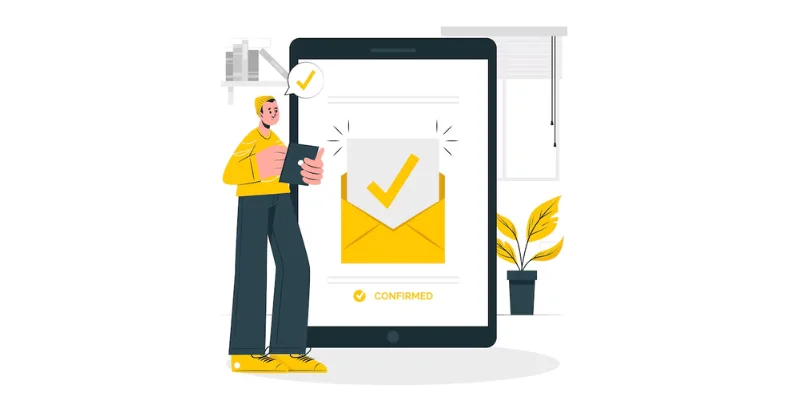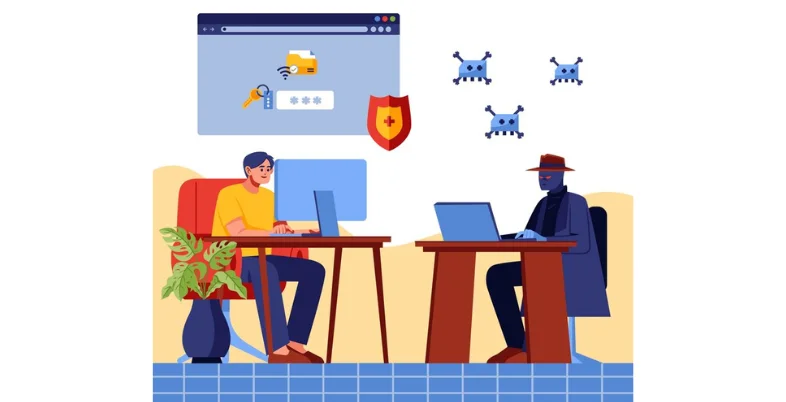Have you ever thought about whether your email is really secure? The modern world is packed with cyber risks, so it is important to protect the privacy of your communications.
It is here where DMARC perfectly fits. But what is DMARC, and how does it shield your inbox from phishing and email fraud?
DMARC is an email authentication standard that is focused on email security. It does this by giving senders the option of telling the system what should be done with an email if it fails authentication, thus giving the service a strong line of defense against spoofing and phishing.
In this blog, we will dive into the concept of DMARC and explain how it works to keep your organization safe from email-based threats.
What Is DMARC?
DMARC is an essential email authentication standard used to protect against phishing and email scams. It allows email senders to make declarations about their emails and the actions to be taken on messages that fail authentication. DMARC operates on top of other authentication techniques, like SPF and DKIM.
Organizations can easily monitor email authentication policies and regulate their email environment. One of the main benefits of DMARC implementation is that senders can get feedback about failures in email authentication and take necessary actions to prevent potential threats.
DMARC is a mechanism that authenticates email addresses and provides feedback loops to ensure that domain spoofing does not occur and recipients are not subjected to malicious emails.
In other words, DMARC is an important instrument in the struggle against email-borne attacks to improve the security and reliability of digital messages. Its adoption is becoming more critical for organizations that want to maintain the integrity of their brand as well as protect customers from phishing and other illicit activities.
SUGGESTED READ: Best AI Tools for Mobile App Development
Why is DMARC important?
- Phishing Prevention: The DMARC protocol is significant for combating phishing emails because it identifies what should be done with unauthorized emails from particular domains. This makes it difficult for cybercriminals to use genuine domains to send spam emails that might land recipients in phishing traps.
- Email Fraud Mitigation: DMARC helps reduce email fraud by authenticating emails and applying policies concerning email handling. It also filters the emails received and reduces fraud cases, like CEO fraud and domain spoofing.
- Brand Protection: DMARC enhances the safety of the reputation and trust in a brand domain. It ensures that the domain name is not used for illegitimate activities that could harm the brand’s reputation among customers, partners, and investors.
- Enhanced Email Security: DMARC works to increase general email security by building on other authentication standards such as SPF and DKIM. It offers organizations visibility and control over their email environment and helps them identify and prevent email threats.
How Does DMARC Work?

DMARC is an email authentication system that tells email receivers whether email senders want to receive messages that fail DMARC authentication checks. Here’s how it works in detail:
1. Sender Policy
In the DNS, the domain owner posts a DMARC policy that informs receivers of what action they should take when they receive emails indicating that they originated from a particular domain.
2. Email Authentication

DMARC uses existing authentication protocols like SPF and DKIM to identify emails from spoofed domains.
SPF authenticates the sending SMTP server’s IP, while DKIM authenticates the content of the email by signing the cryptographic hash.
3. Policy Enforcement
When receiving an email, the receiver will check if SPF/DKIM is published according to the policy defined in the sender’s DMARC record.
The email will be routed if authenticated and consistent with the policy. If it does not pass the identifier or authentication test or does not meet the policy, an entity is supposed to follow the instructions in the DMARC policy provided by the receiver.
4. Policy Actions
There are three common actions associated with a DMARC policy: “none,” which means no action is taken, but reports are generated; “quarantine,” which means messages are marked as spam or placed in a spam folder; or “reject,” which means the message is not delivered.
These actions serve to safeguard the recipients from phishing encounters and email fraud.
5. Reporting
DMARC also offers some reporting features, which can be used to get feedback on the email authentication process outcomes from the owner of a particular domain.
These reports have details of emails that completed their authentication processes, which is important as it helps the domain owners determine if there is any misuse of their domains.
Benefits of Implementing DMARC
Below are some key advantages of implementing DMARC:
1. Enhanced Email Deliverability:

DMARC is applied to improve email deliverability by decreasing the instances where a secure email can be classified as spam or refuse to be delivered by the recipient server.
DMARC protocols officially supporting SPF and DKIM protocols are responsible for confirming the domain from which the email is being sent to know if it is an authentic domain or not.
2. Protection Against Domain Spoofing and Impersonation:
One of the most important reasons for using DMARC is to protect the domain from being spoofed and used in phishing attacks.
With DMARC, the domain owner is also enabled to indicate the action to be taken on an email that fails authentication; for example, quarantining or rejecting emails claiming to come from the organization helps in reducing fraudulent emails, thereby protecting the brand.
3. Reduction in Phishing Attempts and Email Fraud:

Phishing is one of the most common cybercrimes and still poses a great threat to various organizations big and small alike, resulting in serious losses, including data breaches and financial losses, as well as blobbling the organization’s reputation.
This is important in that it acts as a valuable tool in fighting phishing by allowing the owners of the domain to impose rules on email authentication, which in turn makes it harder for the phishing criminals to counterfeit trusted entities and dupe the recipient into providing confidential information or performing some malicious activity.
4. Compliance with Regulatory Requirements:
Numerous legal acts, including the General Data Protection Regulation (GDPR) and the Health Insurance Portability and Accountability Act (HIPAA), require organizations to put in place measures that ensure the confidentiality, integrity, and availability of some information, including email exchanges.
Organizations that use DMARC can show their customers that they are committed to improving email security and following the necessary legal rules to avoid future consequences in the form of fines for violating data privacy laws.
5. Insightful Reporting and Visibility:
Aggregate and forensic reports are used to reveal insights into organizations’ email networks through DMARC.
These reports provide information on email authentication results, passing, failing, and alignment rates, as well as action data, such as failed authentication origins and possible abuse of email domain names.
Through such reporting, an organization can determine the presence of vulnerabilities, the efficiency of their email cyber security strategy, and prevent phishing and other email-based attacks.
6. Maintaining Brand Reputation and Trust:
The era we are living in is full of competition, and therefore,it is crucial for any business to ensure that customers’ confidence in its services is not lost.
This is especially true for organizations that act to protect their consumers from phishing and email fraud by applying DMARC and similar mechanisms; such organizations show that they care about their customers and take responsibility for their engagements on the Internet.
This in turn ensures that the quality and integrity of its brands remain protected; it maintains customer loyalty; and it differentiates itself as a reliable entity in the eyes of consumers.
Common DMARC Misconceptions
DMARC Stops Spam
One common misconception is that DMARC is only designed to stop spam. It is also important to note that although DMARC can assist a person in reducing the amount of spam and phishing messages received in their inbox, the main purpose of this mechanism is to identify legitimate messages and prevent domain spoofing and email fraud. It deals with authenticating the origin of email instead of using text-based spam detection.
DMARC Implementation Is Complex
One of the common myths is that it requires great expertise to adopt and use DMARC technology. At first, it can seem complicated, but actually, the process of implementing DMARC is not very difficult.
It is possible to state that organizations of any size can benefit from DMARC if they receive sufficient resources and proper support during the implementation phase.
There are some websites and applications that offer support during the process and guide you through each step.
DMARC Is Only for Large Organizations
It has been argued that DMARC is pertinent (or otherwise) only to large organizations with complex technical support.
However it is crucial to note that DMARC is also useful for small enterprises and individuals. Any entity that sends e-mails from a domain stands to gain from DMARC, as it helps one to protect against email spoofing and other frauds.
However, small businesses and individuals may be more exposed to phishing and fraud because of their low profile.
DMARC Guarantees Email Delivery
One of the statements that creates the illusion that DMARC ensures emails reach recipients’ inboxes.
It should be made clear that DMARC does not guarantee email delivery, but it does make email delivery more reliable by reducing the chances of perfectly legitimate emails being sent to spam or rejected outright.
There are other factors, too, like sender reputation, content, and any kind of policies that the recipient’s server might have.
Furthermore, policies established by domains’ owners, like ‘reject’ or ‘quarantine’, as part of DMARC might affect email delivery in accordance with the way that receivers deal with unauthenticated messages.
DMARC is a set-and-forget solution
There is also a risk that some organizations will think that once DMARC is adopted, it is now a passive system that requires no monitoring or maintenance.
But the sad thing is that DMARC needs to be constantly monitored, maintained, and even changed over time.
DMARC does not function as a set-it-and-forget-it technology; organizations must frequently examine the reports, assess the outcomes of authentication, and adjust policies according to the received feedback.
In addition, regular monitoring of new threats and tips on how to protect the system from them are crucial to ensuring effective email security.
Ending Note
In conclusion, it can be stated that DMARC serves as the most effective defender of the emails’ security. DMARC helps protect companies from bad actors targeting email infrastructure. But security can be achieved only if it is constantly maintained and changed.
Monitor new threats, update your DMARC settings, and use reports to improve your security over time. It is possible to strengthen protection and prevent the spread of unverified information with the help of the right tools and a proactive mind.






